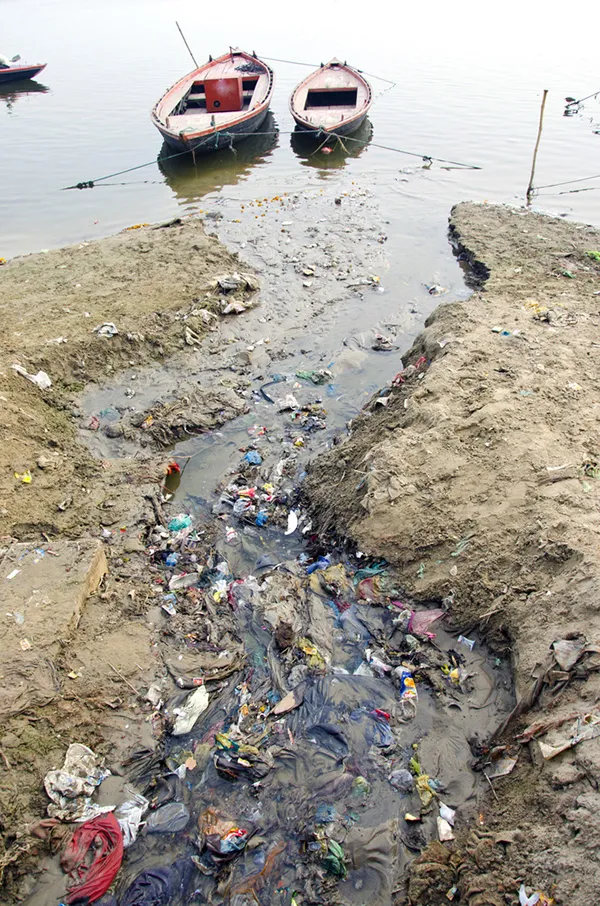Sins of Kanpur flow into Ganga, soiling the holy river
The NDA government has earmarked Rs 2,037 crore for the Integrated Ganga Conservation Mission. But will that act as a final call for tanneries at Kanpur to clean up?
In 1801, a city was born on the banks of the oldest and purest river of India: Ganga. The city went by the name of Cawnpore back then. Untouched by the cruel hands of industrialisation, the people prayed and used the pious river in minimal ways. There was an order, and it was good. It is not good now. It has been more than two hundred years and the city stands as the largest in the State, second largest in northern India. But all this happened at a cost that destroyed the purity of Ganga.
The first leather factory of India was set up in Kanpur by British. It was just the start. With rapid industrialisation, came more tanneries, factories and industries. By 1890, many leather factories were established in Uttar Pradesh, Bombay, Bengal and Central India. But it was this city that British had eyes on. The sole purpose behind the establishment of the city was to be a hub of supply of arms and logistics for British soldiers.

Image: Shutterstock
The two World Wars led to the establishment of more tanneries and product manufacturing factories in Kanpur, Agra, Chennai and other places. Kanpur, as now we know it, is famous for more than just being a historical place. It is known for its growth, money, leather factories and pollution. There is one title that this city is always bestowed with- 'Most Polluted City of Uttar Pradesh'.
A river deceived
According to a report by the Central Pollution Control Board, the flow of Ganga river in Kanpur is almost half of what it is in Varanasi and Allahabad and the sewage generated is double- 339.3 MLD (highest in the state). The capacity for the sewage treatment is only 171.1 MLD. The river suffers from myriad problems, most significant ones being the lean flow during the dry season.
Kanpur is a home to 5,500 industries, including 75 medium and large industries of fertilizers, detergents, paints etc. Out of these, there are about 350-odd leather industries located in Jajmau, near Ganga. It is these leather factories that are the main reason for pollution of Ganga.
Siddhnath Temple on the shores gets brimmed with devotees every Monday, especially at the beginning of the monsoon season. When I last visited the temple a few months ago, I found the river to be a pale, shrunk dump of industrial wastes and dead corpses. The goddess, as Ganga is called, is not pious and holy anymore.
When Kanpur Jal Sansthan collected the water samples in the last week of December 2012, it indicated that 24 lakh coliform bacteria are present in per 100ml water of the river. This is 48 times higher than the standard value. Similarly, the quantity of poisonous chemical nitrate was found to be double of the standard value.
Faith, not devotion
Faith of the people in Ganga is bigger than their own selves. On one of the ghats of the river, a group of devotees from far-off villages and other parts of the city were gathered, ready to take a ‘holy dip’ in the river. On their faces, you could see the delight of getting the opportunity to be rid of all the impurities in a single dip. They were not concerned about jumping into what was pale, yellowish-brown water. I requested an old lady who was sitting by the side of the ghat to not take a dip as the water will do more damage than good. “Son, we know what Ganga Mata is capable of. It will cleanse us. No industry can pollute her. If we don’t take a bath here, we will not get moksha (liberation),” she said.

Image: Shutterstock
To me, that answer was both unbelievable and shocking. I asked a panditji why the practice is not being stopped. “People come here because of their belief. No matter who tells them to stop, they won’t as faith is something the people value most,” he said.
Business gets better of the river
River Ganga comes under the protection of Water (Prevention and Control of Pollution) Act 1974. According to this law, no industry is allowed to discharge its effluents and toxic waste without any proper treatment. For this, the industries have to establish effluent treatment plants. For discharging the waste, the industries had to obtain prior permission from the Uttar Pradesh Pollution Control Board (UPPCB). That permission is only valid for four months with certain conditions. But not all tanneries get these permissions renewed. The law gives power to any citizen to make an appeal if he/she feels that a certain industry is not complying. The pollution control board can take severe actions, including shutting down of that industry.
Some of them have been closed down, of course, but the present scenario indicates that many more are still up and running, spewing their waste without treatment into the river. Before the start of the world-famous Kumbh Mela in January 2013, UPPCB shut down 81 tanneries that did not meet the set standards. The situation is worse than imagined. No matter how many tanneries are shut down, there is no change in the deterioration level of the river. It is now even called ‘dead’ as there is no aquatic life present while people of Kanpur get various water-borne diseases from the river. The reason for the increase in the water pollution is also because of the fact that there is no natural flow in the river. A major quantity of the water is diverted at Haridwar through Upper Ganga Canal system. No major tributary joins the river between Narora and Allahabad. With Kanpur situated in between, this makes the stretch more vulnerable.
Now as the Modi government earmarks a huge amount for Ganga’s rejuvenation, which involves riverfront development, beautification of ghats and development of waterways, will the river see any substantial decline in pollution? The sewage treatment plants being proposed will not cover the tanneries that are expected to treat the wastewater on their own, a function that is not properly monitored by the state agencies. The question remains whether all the talk about Ganga is going to benefit the river and if all of us who consider it holy will actually start treating it as holy.







